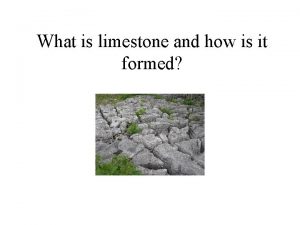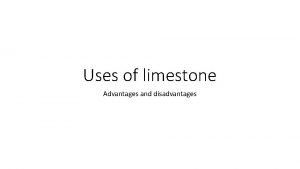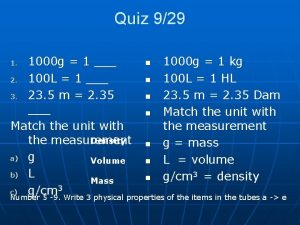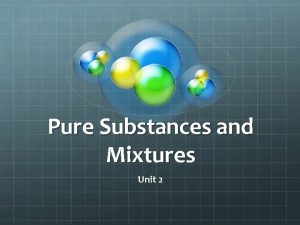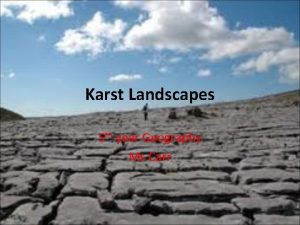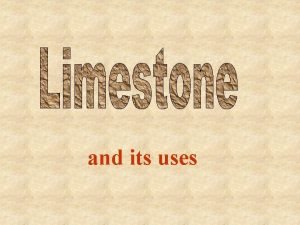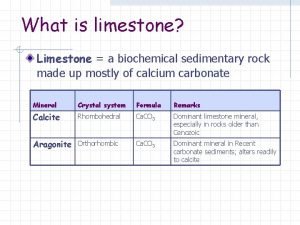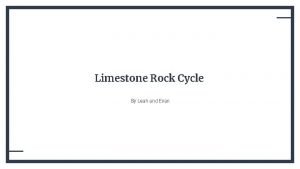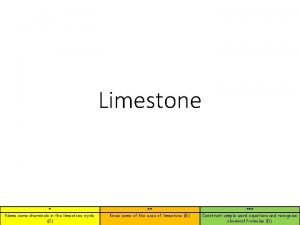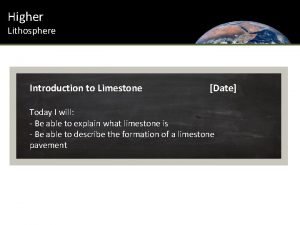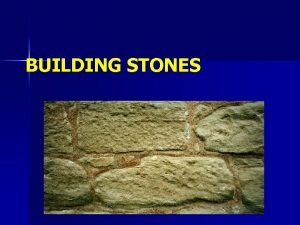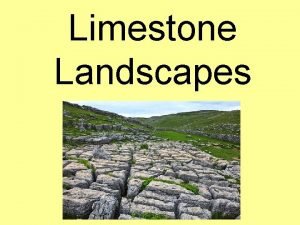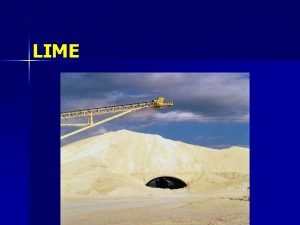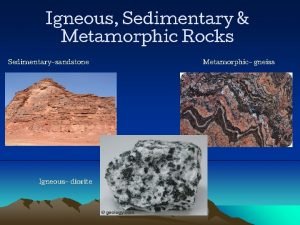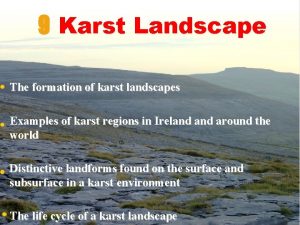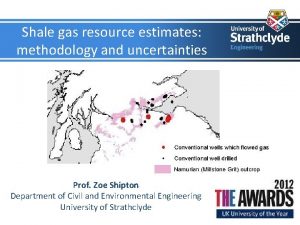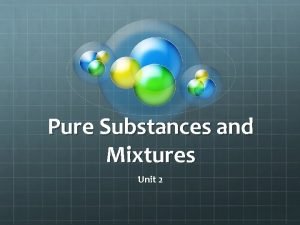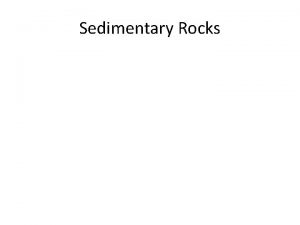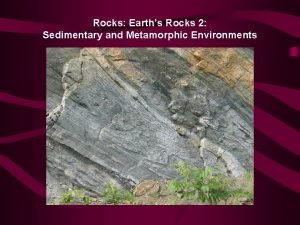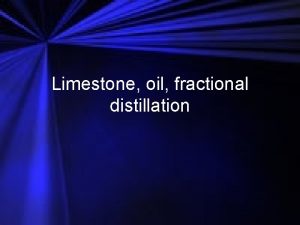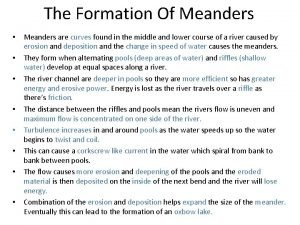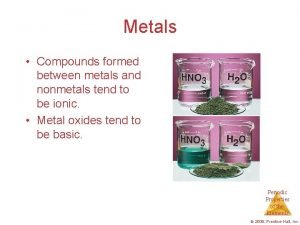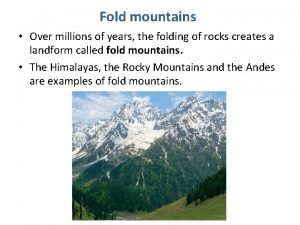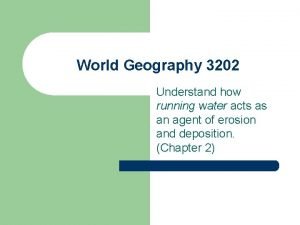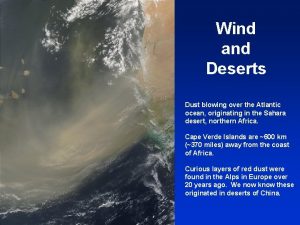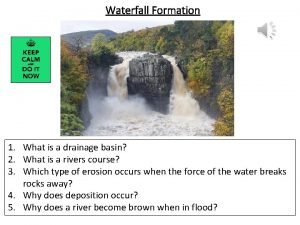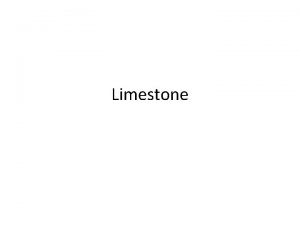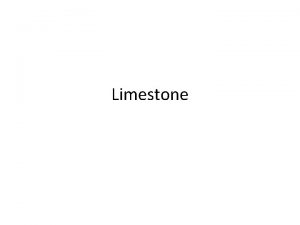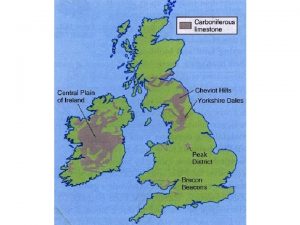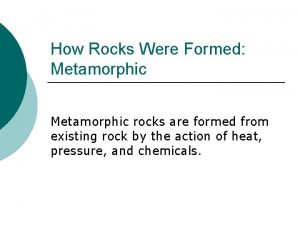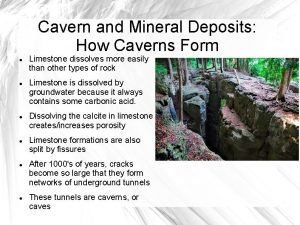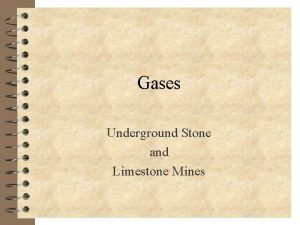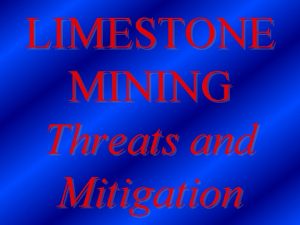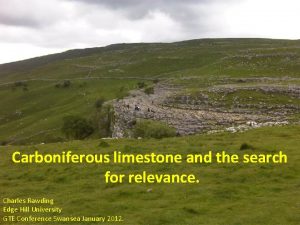What is limestone and how is it formed








































- Slides: 40

What is limestone and how is it formed?

How is Limestone formed?

Task: • Using the information on the next slide you should come up with no more than 3 sentences that explain how limestone is formed and exposed to the elements. – It doesn’t have to be as detailed but needs to show an understanding of the origins of limestone.

Formation Limestone is formed from the fossilised remains of countless marine plants and animals, such as corals, which lived during the Carboniferous period, 345 - 280 million years ago. These former sea beds were moved from the Equator due to continental drift and forced above sea level 280 - 230 million years ago. During Glaciation the topsoil is scoured from the landscape exposing the limestone underneath to weathering.

Carboniferous limestone landscapes are the result of: - • The rock is divided into blocks as a result of breaks between the rock beds (bedding planes) • Vertical cracks (joints) are created as the limestone dries out and pressure is released. joint bedding plane • permeability - water passes easily through the rock by following the bedding planes and joints.

Limestone Features

Limestone features Caves and caverns Limestone pavements Limestone gorges Stalactites and stalagmites Carboniferous limestone features Intermittent drainage Pot holes, swallow holes and shake holes

Now to make a cheat booklet:

Limestone landscapes Malham, in the Yorkshire Dales, is famous for its limestone scenery. One feature that is particularly prominent is the limestone pavement. .

Limestone Pavement - scraped clear of soil by repeated glaciation.

Limestone landscapes We can think of the limestone pavement as a chocolate bar: Limestone is an alkali rock and is weathered by rain which is acidic. Any water that lies in cracks within the rocks, dissolves the limestone over a long period of time, causing the cracks to widen. Clint Gryke

Limestone pavements

CLINT GRIKE Limestone pavement, showing its characteristic clints (blocks) and grikes (gaps).

Limestone Pavement Grikes Before weathering After weathering Clints Joints Bedding planes



Gaping Gill Clapham Beck Head limestone pavement

2009 Higher Paper 1, Question 6 b Choose any one Carboniferous Limestone feature described in your answer to part (a) and, with the aid of annotated diagrams, explain how it was formed. Marks 6

Probably the most obvious (sensible!) Carboniferous Limestone feature to choose would be a limestone pavement although some candidates may focus on limestone caves and their associated underground landforms such as stalactites, stalagmites and rock pillars. Answers which fail to make use of diagrams should score a maximum of 4. Sufficiently well annotated diagrams ought to be able to earn full marks. In explaining the formation of a limestone pavement, for example, candidates could refer to such points as: • the part played by glacial erosion (abrasion) in scraping away any overlying soil cover and thus exposing the horizontally-bedded, rectangular blocks of limestone. • joints formed in the limestone as it dried out and pressure was released. • these joints/lines of weakness are more prone to chemical weathering than the surrounding limestone. The limestone is dissolved over time by rainwater (weak carbonic acid) leaving deep gaps (grykes) and intervening blocks (clints). • continued weathering (both physical and chemical) will further deepen and widen the grykes. Assess out of 6. Max 2 marks for describing features if no explanation given. 6 marks

Swallow Holes and Pot Holes • Because limestone is a permeable rock, there are few surface streams. • Streams that flow onto limestone quickly fall into one of the many enlarged joints on the surface and disappear underground. • Where a river goes underground it is called a swallow hole or a pot hole.

Swallow holes and pot holes The stream disappears into the ground

Limestone features


Swallow Hole

Limestone features

Caverns • Caverns form where some of the underground limestone is dissolved more quickly than the rock around it. This happens when the rock has many joints and bedding planes close together. • These cracks allow through lots of water, which dissolves away the rock completely and a cavern forms.

Limestone features

Stalactites Form in the following way: • The water that drips into the cavern is laced with calcium carbonate that has dissolved on its passage through the rock. • The water drips from the cavern roof very slowly and some of it evaporates leaving behind calcite deposited on the cavern roof. • The water continues to drip, evaporating as it does so, and the deposits build up to form fingers of calcite that grow downwards into the cavern.

Stalactites They grow by only a few millimetres a year. They grow slowly, partly because the water cannot hold much dissolved limestone and partly because the caverns are cool and not much evaporation takes place.

Stalagmites • Some of the water drips onto the cavern floor where it may also evaporate. • It leaves behind calcite here as well, which is deposited on the cavern floor. • As more water drips down, more is deposited forming fingers of dripstone that grow upwards from the cavern floor. • These are called Stalagmites.

Stalagmites Sometimes stalagmites and stalactites join together to form a limestone pillar.

Caves of Drach

Limestone gorge

Stalactite revision

Limestone landscapes

Limestone landscapes

Carboniferous limestone features

Key ideas Limestone solution is the key to understanding all types of limestone features. It is a form of chemical weathering. Limestone features include caves, scars, gorges, limestone pavements, stalactites, stalagmites, clints, grykes, swallow holes and intermittent drainage. Carboniferous limestone is a particularly tough form of limestone which formed about 350 million years ago and is found in the UK mostly in the north of England Ireland. Land uses in limestone areas include tourism, quarrying, farming, forestry and military use. Many of the groups that use the land are in conflict with each other.

Glossary Alkali – Any substance which, when dissolved in water, has a p. H greater than 7. Acid – Any substance which, when dissolved in water, has a p. H less than 7. The opposite of an alkali. Calcium carbonate – The chemical composition of limestone. Carboniferous limestone – A type of limestone normally occurring in thick beds, formed in the carboniferous period. Chemical solution – The process of weathering in which limestone rock is dissolved by acidic rain. Chemical weathering – The process by which rocks are decomposed, dissolved or loosened by chemical means.

Glossary Clints – Solid blocks of rock that make up limestone pavements. Grykes – The cracks between the clints in limestone pavement, formed by chemical solution. Limestone – A sedimentary rock, formed by deposits of marine creatures. Limestone pavement – A surface area of limestone weathered in such a way as to form clints and grykes. Weathering – The natural decomposition of rocks into smaller particles over time. Yorkshire Dales – An area in North West Yorkshire, where the underlying rock is principally carboniferous limestone.
 Formation of a swallow hole
Formation of a swallow hole Holme park quarry
Holme park quarry Sulfur dioxide and limestone
Sulfur dioxide and limestone Nnn+nn+n+n+n=1000
Nnn+nn+n+n+n=1000 Is limestone a pure substance or a mixture
Is limestone a pure substance or a mixture Karst definition geography
Karst definition geography Chapter 7 aquatic ecosystems
Chapter 7 aquatic ecosystems Where is limestone used
Where is limestone used Is limestone a biochemical sedimentary rock
Is limestone a biochemical sedimentary rock Https://geology.com/rocks/
Https://geology.com/rocks/ Limestone cycle equations
Limestone cycle equations Horizontal lines in limestone
Horizontal lines in limestone Basalt limestone
Basalt limestone Chapter 9 environmental science
Chapter 9 environmental science What is this ?
What is this ? Lime is obtained from the calcination of
Lime is obtained from the calcination of How rocks are formed
How rocks are formed Karst landscape examples ireland
Karst landscape examples ireland Limestone sandstone shale
Limestone sandstone shale Types of mixtures
Types of mixtures Limestone chemical formula
Limestone chemical formula Rock
Rock Limestone
Limestone How are sedimentary rocks formed
How are sedimentary rocks formed Granoblastic
Granoblastic Fractional distillation
Fractional distillation Use of limestone
Use of limestone The formation of meanders
The formation of meanders How to solve secants tangents and angle measures
How to solve secants tangents and angle measures How are meanders created
How are meanders created Angle formed by tangent and chord
Angle formed by tangent and chord Member of propaganda movement
Member of propaganda movement Compounds formed between metal and nonmetals
Compounds formed between metal and nonmetals Open center curls produce
Open center curls produce Rift valley india
Rift valley india 3-2 angles formed by parallel lines and transversals
3-2 angles formed by parallel lines and transversals Bead like structures formed by dna and histone molecules
Bead like structures formed by dna and histone molecules How are deltas formed
How are deltas formed What causes wind to blow
What causes wind to blow How a waterfall is formed
How a waterfall is formed Ornithine cycle operates in
Ornithine cycle operates in
